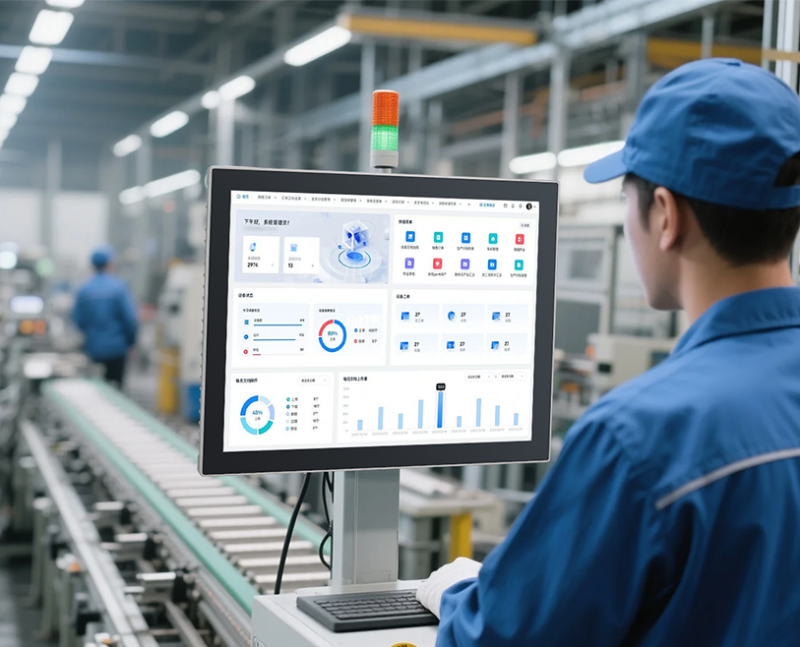In modern production lines—whether for automotive parts, electronics, or consumer goods—delays, errors, or equipment failures can derail entire workflows. The ability to track operations in real time isn’t just a “nice-to-have”—it’s essential for keeping lines running smoothly, catching issues early, and meeting production targets. This is where Industrial HMI Screens (Human-Machine Interfaces) shine: they serve as the central hub for real-time monitoring, aggregating data from sensors, API, and machines to display critical metrics—like production speed, error rates, and equipment status—with clear visuals and instant alerts. Unlike traditional dashboards that require manual checks, Industrial HMI Screens put live, actionable data directly in front of operators, letting them respond to problems in seconds instead of minutes. This guide will break down how Industrial HMI Screens enable effective real-time line monitoring, what features matter most for production environments, and how to optimize them for your specific line—helping you minimize downtime and maximize productivity.

Core Real-Time Monitoring Features of Industrial HMI Screens
Industrial HMI Screens for production lines are designed to turn raw data into meaningful insights. These features are non-negotiable for effective real-time monitoring:
1. Live Production Metrics Visualization
Operators need to see key line performance data at a glance—Industrial HMI Screens deliver this with intuitive visuals:
KPI dashboards: Display real-time metrics like “Units Produced per Hour,” “Overall Equipment Efficiency (OEE),” and “Defect Rate” in graphs, gauges, or digital counters. For example, a speedometer-style gauge might show if the line is running at target (green) or below target (red).
Line status maps: A digital layout of the production line, with color-coded indicators for each machine (Par exemple, green = running, yellow = idle, red = error). Operators can tap a machine icon to see details (Par exemple, “Error: Jammed conveyor”).
Trend charts: Show how metrics change over time (Par exemple, 1-hour or 8-hour trends) to spot patterns—like a gradual drop in production speed that might signal an upcoming equipment issue.
2. Instant Anomaly Alerts
Real-time monitoring means catching problems before they escalate—Industrial HMI Screens do this with proactive alerts:
Configurable thresholds: Set limits for metrics (Par exemple, “Defect Rate > 5%” or “Temperature > 60°C”)—the screen flashes a red alert and plays a sound when thresholds are crossed.
Root cause hints: Advanced screens link alerts to possible causes (Par exemple, “Conveyor idle: Check for jammed parts in Zone 3”) to speed up troubleshooting.
Alert logging: Automatically save alert history (time, metric, action taken) for later analysis—helping managers identify recurring issues (Par exemple, frequent jams on Machine 4).
3. Machine-Level Data Drill-Down
Beyond line-wide metrics, operators need detailed data for individual machines:
Tap-to-access details: Tap a machine icon on the line map to pull up real-time data like “Motor RPM,” “Pressure Levels,” or “Maintenance Due Date.”
Remote control (where safe): For authorized operators, some screens let you adjust machine settings remotely (Par exemple, “Increase conveyor speed by 5%”) to fix minor issues without stopping the line.
Maintenance reminders: Display upcoming maintenance tasks (Par exemple, “Lubricate bearings on Machine 2 in 2 hours”) to prevent unplanned downtime.
How to Set Up Industrial HMI Screens for Effective Line Monitoring
Proper setup ensures your Industrial HMI Screens deliver accurate, useful real-time data. Suivez ces étapes:
1. Map Line Workflows and Prioritize Metrics
Document your line: List all machines, capteurs, and processes (Par exemple, “Feeder → Assembly → Quality Check → Packaging”) to identify which data points matter.
Prioritize critical metrics: Focus on 5–7 key metrics (Par exemple, OEE, defect rate, line uptime) instead of overloading the screen with data. For example, a electronics line might prioritize “Solder Temperature” and “Component Placement Accuracy.”
Involve operators: Ask frontline teams which metrics they check most often—their input ensures the screen displays information they actually use.
2. Integrate with Line Systems (Sensors, API, MES)
Industrial HMI Screens rely on data from other line systems—seamless integration is key:
Connect to PLCs: Use standard protocols (Modbus TCP, Ethernet/IP) to pull real-time machine data from PLCs. Ensure PLC firmware is up to date for compatibility.
Link to sensors: Connect temperature, pressure, or proximity sensors directly to the HMI (or via a gateway) to monitor conditions like “Coolant Temperature” or “Part Presence.”
Sync with MES: For end-to-end visibility, integrate the HMI with your Manufacturing Execution System (MES)—this lets you link real-time line data to broader goals like “Daily Production Target” or “Order Status.”
3. Optimize Screen Layout for Usability
A cluttered screen defeats the purpose of real-time monitoring—keep it simple and intuitive:
Zone the screen: Divide the display into sections (Par exemple, top = KPI dashboard, middle = line status map, bottom = alerts) so operators know where to look.
Use color strategically: Stick to a consistent color code (green = good, yellow = warning, red = error) to avoid confusion. Avoid bright, distracting colors for non-critical data.
Test with operators: Have operators use the screen for a shift and provide feedback—adjust layout or metric placement based on their input (Par exemple, move “Alerts” to the top if operators miss them).
Tips to Maximize Real-Time Monitoring Value with Industrial HMI Screens
Once set up, these practices ensure your HMI screens continue to drive efficiency:
1. Train Operators on Alert Response
Create a “response playbook” for common alerts (Par exemple, “If ‘Conveyor Jam’ alert appears: 1. Stop line 2. Check Zone 3 3. Log action in HMI”).
Hold regular training sessions to practice alert response—this reduces time spent troubleshooting during actual issues.
2. Analyze Historical Data for Continuous Improvement
Use the HMI’s data logging feature to review trends (Par exemple, “Line downtime peaks on Mondays at 10 AM”).
Identify root causes (Par exemple, “Monday downtime = weekend maintenance gaps”) and adjust processes (Par exemple, add a pre-shift check on Sundays).
3. Keep the System Secure and Updated
Restrict access: Assign user roles (Par exemple, “Operator” = view data/alerts, “Manager” = adjust settings/log data) to prevent unauthorized changes.
Update software: Regularly update HMI firmware and software to fix bugs, add features, and improve compatibility with line systems.
FAQs About Industrial HMI Screens for Line Real-Time Monitoring
Q1: Can Industrial HMI Screens monitor multiple production lines at once?
A1: Yes—most advanced HMI screens let you switch between line dashboards (Par exemple, “Line 1” → “Line 2”) with a tap. For large facilities, you can use a “plant-wide” dashboard to see high-level metrics for all lines, then drill down into individual lines.
Q2: What if the HMI screen loses power during production?
A2: Industrial HMI Screens for critical lines should be connected to a UPS (Uninterruptible Power Supply) to keep them running during power dips. Additionally, most screens auto-save alert logs and recent data, so no information is lost when power is restored.
Q3: How often should we calibrate the HMI screen to ensure data accuracy?
A3: Calibrate sensors (linked to the HMI) monthly to ensure data accuracy—this is more critical than calibrating the screen itself. For the HMI display, calibrate touch sensitivity every 3–6 months (or if taps become unresponsive).
Q4: Can we access HMI screen data remotely (Par exemple, from a manager’s office)?
A4: Yes—many Industrial HMI Screens support remote access via a secure VPN or cloud portal. Managers can view real-time line data on computers or mobile devices, though remote control of machines is usually restricted for safety.
Industrial HMI Screens are the backbone of real-time production line monitoring—turning scattered data into actionable insights that keep lines running efficiently, reduce downtime, and help meet targets. By prioritizing live metrics, instant alerts, and operator-friendly design, you can create a monitoring system that adapts to your line’s unique needs.
If you’re unsure how to set up Industrial HMI Screens for your production line (Par exemple, need help integrating with your PLCs, want to prioritize metrics for your industry), Remplissez le formulaire sur notre site Web. Our industrial automation experts will analyze your line layout, processes, and goals to recommend a tailored HMI solution—helping you unlock the full potential of real-time monitoring.

